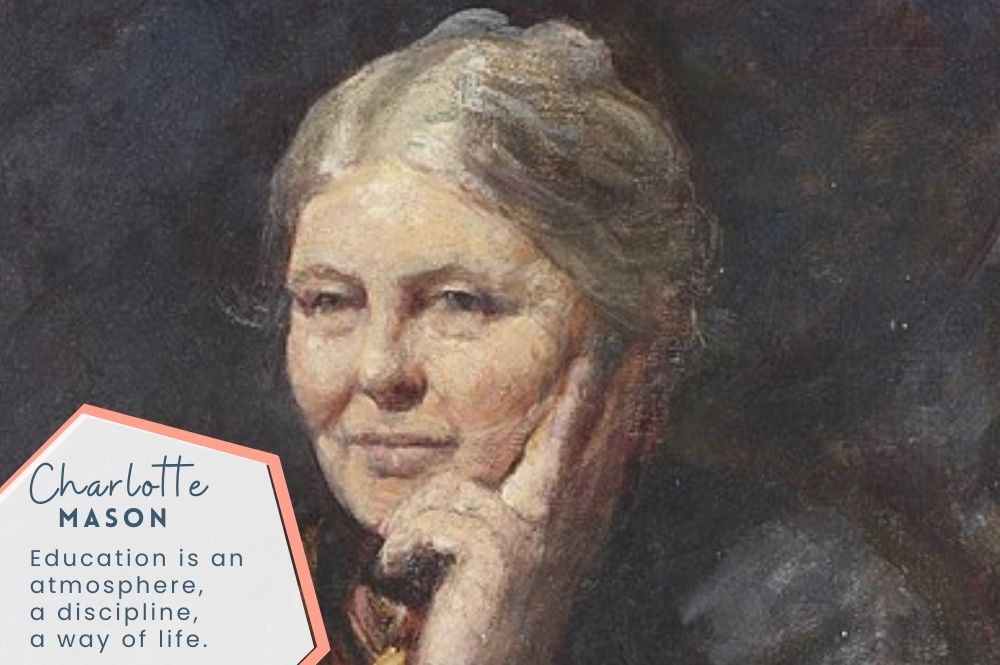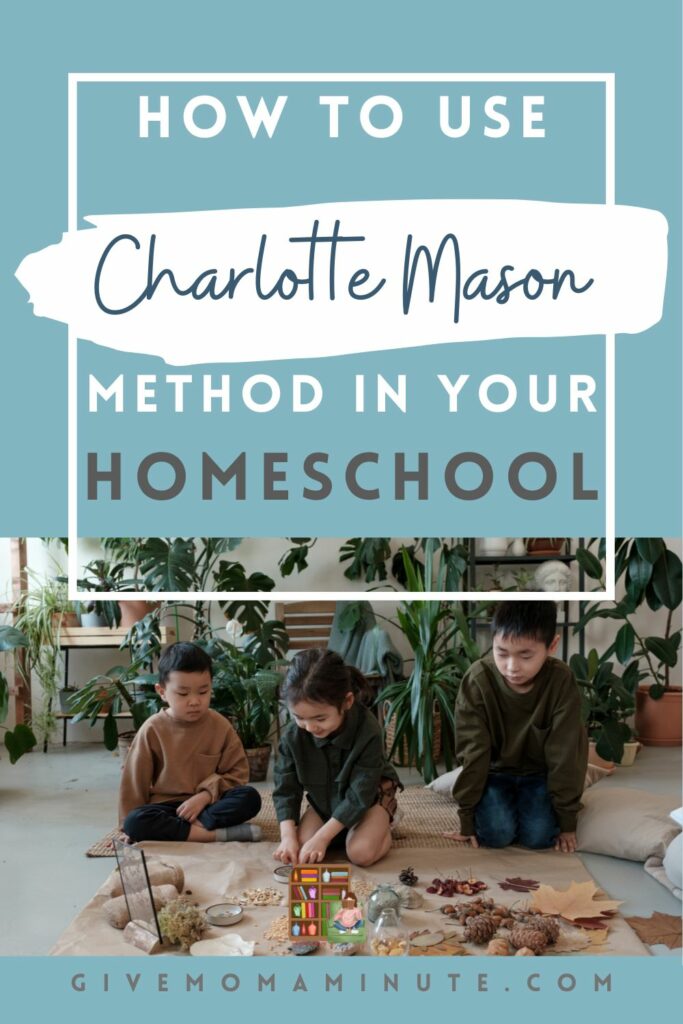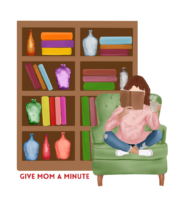You’ve likely heard of the Charlotte Mason homeschool method, but what is it, exactly? Is it right for your family? I fell in love with the Charlotte Mason approach many years ago and have adapted it to suit my family. Today, we’ll take a look at the basics of the Charlotte Mason homeschool method and explore its strengths and weaknesses. By the end, you should have a good sense of whether this educational approach is right for your homeschool room.
Who Was Charlotte Mason?
If you’ve ever done any research into homeschooling curricula, you’ve probably heard of Charlotte Mason. She was a British teacher in the late 1800s. She believed education should be accessible to everyone regardless of class and began writing a newsletter for families to use at home. It is these newsletters that inform our understanding of her methods.
One of her most popular quotes is that education is an atmosphere, a discipline, a way of life. She believed education was about more than just getting a good job or hanging a degree on your wall.
Mason’s educational philosophy was influenced by her own experience as a student, as well as by the work of John Dewey, Friedrich Froebel, and others. She believed that education should be holistic, focusing not only on the intellectual development of students but also on their emotional and spiritual growth

Is a Charlotte Mason Homeschool Literature Based?
The Charlotte Mason homeschool method is an educational approach that emphasizes experiential learning, moral formation, and a love of learning. It’s based on three main principles.
- Education should be based on the principle of interest – This means that lessons should be designed to capture and maintain students’ interest, rather than being purely didactic or rote-based. A variety of teaching methods can be used to achieve this, including story-telling, drama, hands-on activities, field trips, and so on.
- Education should develop all aspects of the child’s nature – This means that lessons should not just focus on academic subjects but also on developing other aspects of the child’s character, such as their sense of wonderment, creativity, imagination, self-discipline, and so forth. Again, a variety of teaching methods can be used to achieve this goal.
- Education should be life-long – This principle emphasizes the importance of continued learning throughout one’s life – not just during childhood or adolescence but throughout adulthood as well. It is based on the belief that we never stop growing and evolving as human beings, and that education should reflect this fact.
Additionally there is the belief that children are born persons with their own unique gifts and talents. This means that education should be tailored to each individual child, rather than one-size-fits-all.
One of the hallmarks of the Charlotte Mason homeschool method is “living books.” These are books that are rich in ideas and beautifully written. They’re meant to be enjoyed and savored, not just read for information. The theory is that if children are exposed to great literature, they will be inspired to become great thinkers and maybe even writers themselves. If our environment is a smorgasbord of ideas and critical thinking, then our kids will have the freedom and knowledge to use those skills in the future.
Another key component of the Charlotte Mason homeschool method is nature study. This involves taking children out into nature on a regular basis so that they can observe and learn about the world around them. Many Charlotte Mason educators believe that this exposure to nature helps children develop a deep appreciation for God’s creation and scientific principles. It fosters stewardship of the earth, one’s own health, and a greater understanding for how the world works.
Note: This is a secular homeschool blog. Charlotte Mason was not secular, but I believe her educational approach and philosophy is valuable. Build Your Library and other secular curricula are loosely based on her ideals.
The Charlotte Mason method is an educational philosophy that was developed by Charlotte Mason in the late 1800s. It is based on the belief that children are born with a natural love of learning and that education should be tailored to meet their individual needs and interests
Strengths of the Charlotte Mason Principles
What are the strengths of the Charlotte Mason homeschool method? First, it values each child as an individual with his or her own unique gifts and talents. It treats children as whole persons and does not encourage blind obedience or the idea that children should be seen and not heard.
Secondly, the Charlotte Mason method emphasizes experiential learning, which many experts believe is more effective than rote memorization. Many of her lessons used hands-on experiences whether this be through nature study or immersion in a language.
Another benefit of using the Charlotte Mason method is that it fosters a love of learning in children. By exposing them to a wide variety of topics and allowing them time to pursue their interests, they are more likely to develop a lifelong love of learning. This is evident in Charlotte Mason’s own life – she continued learning and pursuing new interests even into her old age!
It fosters a love of learning in children by exposing them to beautiful literature, lofty ideals, and great thinkers. It inspires children to become critical thinkers, excellent communicators, appreciative of the world around them.
Finally, using the Charlotte Mason method can help prepare children for success in college and beyond. Because they have been exposed to a variety of subjects and have had practice doing independent research, they will have an advantage over students who have only been taught in a traditional classroom setting.
Pin This for Later

What are the Negatives of Charlotte Mason?
Now let’s take a look at some of the potential drawbacks of the Charlotte Mason homeschool method. When I was doing more of a “purist” Charlotte Mason curriculum, the books were considered living but were also extremely antiquated. Now, I believe there is value in reading literature even if the language is archaic and difficult to understand. But is that a way to foster love of literature in six-year-old? I’m not completely sold on that idea. Some of the books can be hard to find as well as they are now out of print.
A lot of time is spent outdoors which might not be conducive to your climate or family lifestyle. Again, those purists would tell you to suck it up, bundle up, buy a rain coat, and get outside (IYKYK). But, as I’ve said before, I’m not really a purist about much of anything!
Most of the Charlotte Mason education is taught through living books and the use of copy work and narration. These are effective techniques, but can be hard to get used to. Some kids will struggle significantly with this approach.
I followed Charlotte Mason’s ideas pretty strictly with my oldest. He narrated beautifully and worked hard on his copy work. He’s an excellent writer today and naturally knows spelling and grammar rules. This is the way the process is supposed to work.
With my younger kids, though, I had changed from the purist curriculum to other options. We didn’t do copy work or narration as religiously as I had with my son. It could be due to their personalities, but they are not nearly as adept at language arts, and I believe it is in part due to my lackadaisical approach.
HOWEVER, I also didn’t fight with my youngers as much or get into power struggles about how to properly perform a narration. If I could get a do over, I wouldn’t push my son quite as hard as I did. There are other methods to teach excellent grammar and spelling skills.
The final drawback I see to Charlotte Mason’s ideas is that they don’t really come with a guidebook or strict lesson plan. If you need a checklist or need to feel like you have a solid schedule and tasks, then the Charlotte Mason method by itself might not be for you. There are now several secular homeschool curricula that build on her ideas that just weren’t available when I started homeschooling. Her newsletters were intended for parents to use at home, so they give ideas and methods but not true lesson plans.

Is Charlotte Mason the Same as Unschooling?
While Charlotte Mason method for homeschool and unschooling have some similarities, there are certainly differences as well. In both approaches, emphasis is placed on setting a feast of learning for your students. By providing diverse opportunities, the students can choose to develop their own interests.
I’ve heard it described that the major difference between Charlotte Mason and unschooling is WHO provides those diverse opportunities. In unschooling, it is more student-led. With Charlotte Mason, the parent/teacher provides the opportunities and is more selective about what educational feast gets put on the table to begin with.
Unschooling can be very structured or not structured at all whereas Charlotte Mason is generally focused around a schedule with definite learning objectives and timetables.
What is the Difference between Montessori and Charlotte Mason?
When comparing one educational philosophy to another, it’s important to remember how revolutionary these ideas were at the time these women were alive. Montessori and Mason both played pivotal roles in the development of education as well as the psychological and behavioral stages of development. They worked with different populations and came from different backgrounds. Today, many homeschool curricula draw inspiration from both the Montessori and Mason approaches.
In a nutshell, the Charlotte Mason method for homeschool encourages children to observe the world around them and to fill their minds with great ideas, quality literature, and critical thinking skills. In essence, it is based on the mind.
The Montessori approach utilizes environmental conditions and manipulatives to focus on the senses. Children will learn through sensory experiences.
Personally, I choose to draw on the benefits of things I like abut several approaches and methods. This is called eclectic homeschooling, and is more the style used in more recent secular homeschool curricula.

Is Charlotte Mason a Good Curriculum?
There are many reasons why you might want to consider using the Charlotte Mason method in your homeschool. For one, Charlotte Mason’s educational philosophy stresses on developing a child’s whole person – body, soul, and spirit. Additionally, the Charlotte Mason method has been shown to be highly effective in promoting academic excellence and helping children develop a love for life-long learning.
What does a Charlotte Mason Day Look Like?
The Charlotte Mason method is founded on the educational philosophy of Charlotte Mason, who believed that education should be accessible to all, regardless of social class. She believed that education should be holistic, encompassing not just the intellect but also the emotions and the body. She further believed that children are naturally curious and eager to learn, and that it is the role of the educator to facilitate this learning by providing a rich environment full of interesting things to explore.
Here are some areas to focus on when you are incorporating the Charlotte Mason approach into your homeschool:
Nature Study
Make time for nature study. A big part of the Charlotte Mason method is spending time observing and learning about the natural world. This can be done through activities like hiking, bird watching, gardening, and even just playing outside. Schedule some time each week for your family to get outside and explore together.
Incorporate natural materials into your living environment with an ant farm or watching butterflies hatch.

Living Books
Use living books. Another important aspect of the Charlotte Mason method is using quality literature as a foundation for learning. Look for books that are well-written and engaging, and that will inspire a love of learning in your children. Avoid textbooks whenever possible, and instead opt for books that will really capture your child’s imagination.
Charlotte Mason used the word “twaddle” to describe books that were frivolous or didn’t meet her standards for high ideals. Again, I’m not a purist, so give your kids a plethora of books. Include literary classics, but don’t be afraid to include modern literature. It might not be classified as a “living book” yet, but that doesn’t mean your kids won’t learn from it.

Hands On Learning
Encourage hands-on learning. This principle of the Charlotte Mason method is to encourage interactive experiences. This means incorporating lots of activities and projects such as music, art, baking, crafts, etc. into your homeschooling day, rather than just relying on lectures or workbooks. Get creative and let your children learn through doing!
Set High Expectations
Promote good habits and hold your kids (and yourself) accountable. One of Charlotte Mason’s key philosophies was that developing good habits is essential to lifelong success. These include habits like punctuality, neatness, and regularity in your homeschool routine. It also includes setting high expectations for your kids’ school work.

For example, during copy work, your kid might write 3 quality S’s. This is far more desirable than writing 3 pages of S’s that are less than mediocre and barely legible. Instead of judging your kid’s work, though, ask them if this was their very best effort? Some kids will naturally have beautiful handwriting, while others struggle with fine motor skills. The point isn’t that the S is “perfect”. The point is that your kid gave it their very best effort.
Instilling these habits and expectations of delivering their very best will serve your children well both now and in the future.
Alternate Brain Usage
Are you left-brained or right-brained? Is math easier for you or writing? When Charlotte Mason taught her students she believe it was important to work with an intense focus for a short duration of time. She also gave her students brain breaks by alternating the subjects.
For example, if you did math then the next subject would be something more creative, like physical activity, or language arts.
Charlotte Mason-Based Secular Homeschool Curriculum
As I stated above, Charlotte Mason was not exactly secular in her approach. If you need a little more structure for your homeschool schedule, here are a few secular homeschool curricula that utilize parts of the Charlotte Mason method.
- Blossom and Root
- Build Your Library
How Long are Charlotte Mason lessons?
One area where I DEFINITELY agree with Charlotte Mason is the length of the lessons. Focused, devoted time is much more effective for long-term learning then sitting in your chair trying to complete all 100 problems on a math lesson. The general rule of thumb for how long your lessons should be in a Charlotte Mason school is the age of your child plus one minute.
This means for a seven-year-old, intentional nature study or math lessons should take 8 minutes. As kids get older they are able to focus for longer periods of time, but Charlotte Mason never encouraged lessons to be long and tedious. Instead, keep them short and focused. As a result, the kids will be more engaged and more likely to retain the information.
The Charlotte Mason Method is a great way to homeschool your children. It is based on Charlotte Mason’s educational philosophy, which emphasizes the importance of nature, living books, and a child’s natural curiosity. The benefits of using the Charlotte Mason Method include a love of learning, freedom to explore new areas of thought, development of good habits.
Do you have a favorite Charlotte Mason resource? Share it below!



